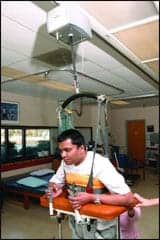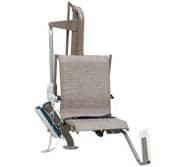Emphasis on training and equipment helps lift services achieve safety goals.
Todd S. Danos, MBA, LOTR

The literature does support preventing complications from immobility, which can facilitate a decreased length of stay and, thus, create a financial benefit to the hospital. Prolonged bed rest has been associated with a number of well-documented adverse outcomes that can have severe consequences, especially for the elderly. Immobility is a well-recognized risk factor for a variety of adverse outcomes such as deep vein thrombosis (DVT), decubiti, and pulmonary insufficiency.1 Timmerman states that complete bed rest orders for prolonged periods should be a rare exception and should be questioned if a legitimate reason is not apparent.1 When bed rest is truly warranted, the rationale should be documented in the medical record at least once per shift. Kress also hypothesized that early mobilization of critically ill patients may offer benefit.2 Brower further described the consequences of bed rest and detailed several of the adverse effects.3 Rest is important for humans to allow healing and natural repair. However, the normally functioning human is physically active for substantial portions of each day, and physical activity has beneficial effects on many aspects of organ and system function.3
Decreased mobility increases patient risks for DVT, falls, pressure ulcers, and other medical issues.4 Decreased mobility, particularly in the elderly and morbidly obese, contributes greatly to increased length of stay.5,6 Lack of physician activity orders further delays early mobilization. Untimely therapy consults also may lead to additional delays in the assessment and treatment of patients due to impaired mobility. In addition to the human toll, Medicare penalties for patients who experience adverse outcomes negatively impact health care financials.
LIFT TEAM
The lift team at EJGH became an integral part of the facility’s mobility initiative. The team consists of specially trained team members from the patient transport department. Their initial training was completed by physical therapy. Education included proper body mechanics, safe patient handling, and competent lift equipment usage. In order to increase awareness of this service, a hospital-wide process to access the lift team was developed.
CREATING THE LIFT TEAM
The lift team at East Jefferson General Hospital consists of team members from the patient transport department. A multitude of factors are considered in the selection of team members, which aims to ensure successful performance.
One of the most important characteristics a team member should possess is the ability to interact well with patients and establish rapport. Given the growing importance of patient relations and customer satisfaction, having team members who can satisfy the patient and provide a great experience during mobility and a lift episode is paramount to success. Team members are provided with education about respect for the patient, especially in light of the fact they are dealing with typically obese patients.
Another important characteristic for a team member is the ability to meet the physical requirements of the job. Though the positions are open to any gender that can perform the job requirements, at this time only male team members fit the requirement. The facility has offered female team members the opportunity to perform mainly lighter lifts and operate equipment used in certain lifts. This has worked well, and eventually those team members will convert to lift team members. Education is provided with a focus on concerns for patient privacy, especially when interacting with female patients. Lift team member ages vary from 24 years through 53 years. Good physical condition and ability to perform lifting duties are also characteristics lift team members should have. These qualities help the speed with which lifts are performed. Two years ago, handheld radios were acquired for the lift team. This greatly increased the speed at which the team can respond to calls from the dispatcher, who knows the location of the lift team members at all times.
TRAINING THE LIFT TEAM
The physical therapists and occupational therapists in any health care facility will always be the experts in patient mobility, transfers, and understanding of body mechanics principles. East Jefferson General Hospital has the benefit of employing many staff members who are experienced therapists. Early on in the program, Beth Siegle, PT, was identified as the physical therapist who possessed the skills and teaching ability to train the facility team in proper lifting techniques, proper body mechanics for lifting, and safe patient handling techniques. Siegle has more than 25 years of experience, is NDT certified, and works on the inpatient rehab unit. She has what are considered the ideal qualifications for this position.
The teaching program consists of a 4-hour session with each lift team member. During the program, different lifting techniques and scenarios are taught, which include supine to sit, sit to stand, bed to chair, bed to wheelchair, and bed to commode. This training includes proper hand placement, positioning of the patient and lift team member for the lift, setup prior to the lift, and proper verbal instructions to give the patient prior to the lift. Also included in the session are basic body mechanics to use during a lift to ensure the health of the lift team member.
The frequency of classes depends on the need to train new lift team members. Fortunately for us, we have a stable core group of lift team members, and have experienced relatively little turnover in the last 2 years. After initial training, team members are competency checked and train with current members to ensure good carryover. Physical therapy also completes a yearly in-service and competency check for all the lift team members to ensure continued safe lift team performance.
WORKING WITH SAFE PATIENT HANDLING EQUIPMENT
Over the last 2 years, the lift team has been fortunate to purchase certain pieces of patient handling equipment for which need has been clearly identified. Several types of equipment were investigated as options to help the facility accomplish its goals, including those based on ceiling track designs. The inventory of equipment that currently is utilized throughout the hospital includes the following:
1. 1000# capacity sling lift
2. 450# capacity sling lift
3. 450# capacity sit to stand
4. 250# capacity steady
5. Two 800# capacity bariatric wheelchairs
6. One 700# capacity bariatric stretcher
7. 1100# capacity air patient lift
Each one of the lift team members is trained in the proper use of these pieces of equipment, and competency is checked each year to ensure safe performance. One key item that was paramount prior to purchasing any of the equipment was the ability to do trial runs with the device being considered for purchase. It was highly beneficial for the facility to work with vendors who allowed some of the equipment that appears above to be trialed, allowing the lift team and physical therapy to provide feedback about use, whether positive or negative. From there, the decision would be made to proceed with the purchase or recommend a different item. Since most of the facility’s equipment is relatively new, there have been no issues with replacement needs. If replacements were required, there is administrative support to replace these items, since all of them would be considered a capital purchase.
OUTCOMES
It has been 4 years since the lift team was formed, and we have seen a good increase in utilization of the team. The initial goals were to help decrease team member injuries, increase mobilization of patients, and ultimately help decrease length of stay.
Another benefit of lift team utilization has been its effect on the falls rate. The lift team has played a part in helping to decrease patient falls. As the usage of the lift team has increased, the number of patient falls within the hospital has decreased. The year 2012 marked the first time the hospital reported the number of patient falls was less than 400. So far in 2013, we are trending to end the year with fewer than 300 falls.
Nurse injuries remain a significant problem in many health care facilities. Due to the lift team efforts, however, we have seen a decrease in injuries related to lifting patients and mobilization of patients across the hospital.
Length of stay has remained a challenge at many hospitals. There are many factors that affect length of stay, which makes it difficult to gage the lift team’s impact in this area. However, given the increased utilization of the lift team, which contributes to increased mobilization of the patient, it can be assumed that implementing the lift team has been a good facilitator in the overall effort to decrease length of stay.
East Jefferson General Hospital has benefitted considerably from the lift team’s success and achievements. This service has been integral in achieving goals associated with patient mobility, decreasing patient complications, and positively affecting injury rates and overall length of stay. Physical therapy has contributed to overall competency of lift team members and ongoing success of the training for patient lifts and mobility. Exploring how the lift team can provide further benefits throughout the hospital will continue to be an area of focus, for the good of patients as well as staff members. RM
Todd S. Danos, MBA, LOTR, is director of Therapy Services, East Jefferson General Hospital, Metairie, La. For more information, contact [email protected].
References
1. Timmerman RA. A mobility protocol for critically ill adults. Dimens Crit Care Nurs. 2007;26(5):175-179.
2. Kress JP. Clinical trials of early mobilization of critically ill patients. Crit Care Med. 2009;37(10 suppl):S442-S447.
3. Brower RG. Consequences of bed rest. Crit Care Med. 2009;37(10 suppl):S422-S428.
4. Needham DM. Mobilizing patients in the intensive care unit improving neuromuscular weakness and physical function. JAMA. 2008;300(14):1685-1690.
5. Critical Path Network. Six Sigma Project slashes LOS for SNF discharges. Hospital Case Management. November 2007:167-169.
6. Padula CA, Hughes C, Baumhover L. Impact of a nurse-driven mobility protocol on functional decline in hospitalized older adults. J Nurs Care Qual. 2009;24(4):325-331.





